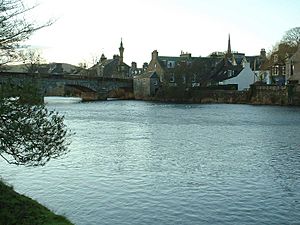River Cree facts for kids
The River Cree is a river in Dumfries and Galloway, Scotland. It flows through the town of Newton Stewart and then into the Solway Firth. This river also marks part of the border between two areas: Wigtownshire and Kirkcudbrightshire.
Contents
Where Does the River Cree Start?
The River Cree gets its water from several smaller rivers called tributaries. These include the Minnoch, Trool, Penkiln, and Palnure. These rivers flow down from a mountain area known as the Range of the Awful Hand. This area has many mountains, lochs (lakes), bogs, and rocky cliffs. The highest point is The Merrick, which is about 842 meters (2764 feet) above sea level. It's about 19 kilometers (12 miles) north of Newton Stewart and you can even see it from the town!
How the River Cree Shaped History
For a long time, the River Cree was like a natural highway. It helped people travel from the coast deep into the forests. Later, it became an important boundary, separating different communities and areas. For example, it divides the parish of Penninghame from Minnigaff. It also separates Newton Stewart from the villages of Creebridge and Minnigaff.
Crossing the River: Bridges and Fords
Before the 1700s, there weren't many bridges over the River Cree. People often had to cross the river at shallow spots called "fords." The main ford was just below where the main bridge is today in Newton Stewart. You can still see how the streets were laid out around this old crossing point. There was also an early wooden bridge and a boat ferry nearby.
The river was also a key source of power. In the 1700s, textile mills were built in Newton Stewart. These mills used the river's flowing water to power their machines, which was very important for industry back then.
Modern Bridges Over the Cree
Today, there are several bridges over the River Cree.
- The Sparling Bridge was built in 1998. It's a steel bridge that's part of a nice riverside walking path. It's named after a special fish called the sparling.
- The newest bridge was built in 1979. It's part of the A75 trunk road bypass, helping traffic go around Newton Stewart.
The River Cree and Trade
Before good roads and railways, people moved heavy goods by sea. Things like coal, wood, and stone were carried on ships. The Cree has a winding, muddy estuary (where the river meets the sea). This wasn't ideal for big ships. However, there were small harbors along the estuary.
- Carty Port, a few kilometers south of Newton Stewart, was one such harbor.
- Other ports further down the estuary included Wigtown and Creetown.
These ports traded goods along the coast. Regular shipping services even connected them to Liverpool. While these old ports are mostly unused now, you can still find active fishing ports further south. These include Garlieston, the Isle of Whithorn, and Port William.
Wildlife in the Cree Estuary
The muddy Cree estuary is a very special place for nature. It's known as a Site of Special Scientific Interest (SSSI). This means it's protected because of its unique wildlife.
The Amazing Sparling Fish
One of the main reasons the Cree estuary is an SSSI is the sparling fish (Osmerus eperlanus). These fish, also called smelt, still breed in the estuary. It's one of only three places in Scotland where they do!
Wigtown Bay Wildlife Reserve
The shore of the Cree estuary is also home to a large area of salt marsh. These muddy, grassy areas are called "inks." Wigtown Bay is now a recognized wildlife reserve. Sheep graze on the salt marshes all year. In winter, huge flocks of wild geese come to stay. The bay is especially famous for the large numbers of pink-footed geese (Anser brachyrhynchus) that spend their winters there.
Fishing Traditions
In the past, people used special nets called "stake nets" to catch salmon in the bay. Another old way to fish for salmon was using "haaf nets." These methods are not as common today. However, many enthusiastic anglers (people who fish with a rod and line) still come to the River Cree every year. They continue to catch good numbers of fresh salmon.


